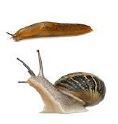What are they?

Slugs and snails feed on a variety of plants as well as on decaying plant matter, chewing irregular holes on the leaves of plants. There are around thirty species of slugs in Britain. Slugs and snails move by means of a muscular foot which secretes mucus along which the animal glides. This mucus later dries to form the tell tale silvery slime trails.
Snails lay approximately 80 round white eggs into holes or harbourages in the soil. It takes about two years for snails to mature and about one year for slugs to reach maturity.
Both slugs and snails need moisture and are most active at night or during cloudy and rainy days. On dry, sunny days snails shut themselves into their shells, sealing the entrance to keep moist. During cold weather slugs and snails hibernate in the topsoil.
Can I treat them?
If the slugs or snails are causing a problem in a garden or outside area, there are a range of slug and snail control products* on the market, which are available from most supermarkets, hardware stores and garden centres.
If slugs or snails are regularly being seen in the home, some relief may be gained by clearing outside vegetation and debris from near to indoor access points and using slug pellets*, if appropriate, to discourage entry. It may also be advisable to check any vegetable purchase for the presence of pests prior to adding them to your stored domestic food. Another effective deterrent is copper tape or strips. These will give snails an electric shock as soon as they come in contact with it. Placing the strip on the floor by the doors/air bricks will act as a barrier. Salt can also be used as a barrier deterrent and should be placed across doorways and near air bricks.
*Always refer to the product instructions BEFORE use and follow these at ALL times.
Last Updated on Wednesday, May 8, 2024